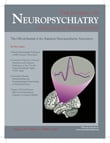SIR: Tardive dystonia is a type of “tardive” movement disorder induced by antipsychotics and is characterized by involuntary muscle contraction, which may be tonic, spasmodic, patterned, or repetitive.
1 Blepharospasm is a type of focal tardive dystonia characterized by chronic intermittent or persistent closure of the eyelids. Although there are rare reports of tardive dystonia induced by atypical antipsychotics, such as olanzapine,
2 clozapine, in contrast, has been reported to ameliorate tardive dystonia.
3 Contrary to existing literature, we report a case of a patient developing blepharospasm with clozapine.
Case Report
“Mrs. F,” a 46-year-old woman, presented with one month of suspiciousness, mumbling to herself, and disturbed biological functions, and she was diagnosed with schizophreniform disorder. Past and family history revealed no psychiatric or neurological illness. Initially, she was treated with trifluoperazine (15mg/day) for 4 months, which was replaced with clozapine due to severe akathisia. The dose of clozapine was increased from 25mg to 100mg/day over a period of 2 weeks after performing hematological investigations, and she was maintained on the same dose for 4 months.
While being treated with clozapine, Mrs. F developed frequent and forceful blinking of her eyelids. She would blink her eyes about 40 times in a minute when exacerbated by bright light. An ophthalmological consultation was unremarkable for any eye pathology contributing to this presentation and the neurological exam did not reveal any abnormal movements, except for the blepharospasm. The patient had no prior personal or family history of blepharospasm or other movement disorders.
Five months later, clozapine was tapered and stopped, but Mrs. F continued to have blepharospasm even 4 weeks after discontinuing clozapine. Subsequently, clonazepam (1mg/day) was started and the blepharospasm disappeared a month after its initiation. Two years later, the patient had a second episode of psychotic illness and was again treated with clozapine, titrated up to 75mg/day. Five weeks later, she exhibited a similar form of blepharospasm, though it was not as severe. Again, clozapine was discontinued and Mrs. F had a complete resolution of the blepharospasm with clonazepam.
Comment
The reappearance of blepharospasm with the administration of clozapine strongly implicates this drug in this dystonic reaction. Blepharospasm is classified as a type of focal dystonia and has been reported to occur with atypical antipsychotics. In contrast to other atypicals, such as olanzapine, which have been anecdotally reported to cause tardive dystonia,
2 clozapine has been used in treating tardive dystonia, including blepharospasm.
3,
4 However, in rare instances, clozapine has been reported to induce tardive dystonia as well.
5 In the above case, the patient developed cervical dystonia 2 years after clozapine was started. Given the rarity of reports of clozapine-induced tardive dystonia, our patient may have developed an idiosyncratic reaction to this drug. This is further supported by the observations that this patient did not develop tardive dystonia with trifluoperazine, which is a more potent D
2 receptor antagonist than clozapine, and that the proposed mechanism of drug-induced tardive dystonia is the sensitization of dopamine receptors following their blockade.
6 Another issue highlighted by this report and the existing literature is that clonazepam is an effective treatment of tardive dystonia,
3 and may be considered before more invasive procedures, such as botulinum toxin, are tried.

